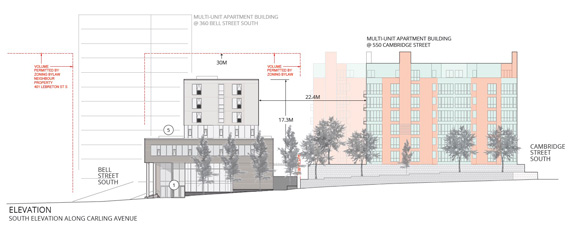John Howard Society meets with Glebe Annex community


Illustration: Courtesy of JHS
By Sue Stefko
On Thursday, March 7, representatives from the John Howard Society (JHS), the City of Ottawa’s Affordable Housing Branch, and Councillor Shawn Menard met with approximately 70 residents of the Glebe Annex and neighbouring communities.
The formal part of the information session included presentations about the JHS – both general, in terms of its mandate and activities, and specific, concerning the 289 Carling site itself. Christine MacIntosh, the JHS of Ottawa’s Associate Executive Director, thanked the community for taking the time to come and meet with them, to learn more about the project and to share their feedback. She reconfirmed some building details provided earlier – the building will comply with the site’s zoning, with the podium housing JHS office staff, building administration and various services (education, job searches, counselling, etc.), and the tower portion containing 40 one-bedroom and bachelor apartment units. Although it is still too early to determine who the clients will be, she reiterated that the city will provide a priority list from which the JHS will select. The clients could be drawn from those living in shelters, residing in other supportive housing (particularly those in a location with intensive support who can be “downgraded” to more moderate support), and those leaving institutions such as hospitals or prisons. The site is expected to provide long-term housing, although this could range from a few months to a number of years depending on an individual’s circumstances.
MacIntosh placed particular emphasis on relationship-building with the local community, emphasizing that she understands that people may have concerns and fears about the clients who will be living here, and underlining that maintaining an open dialogue is important to working through some of these issues.
An open dialogue seems to be what the attendees had in mind, given their numerous questions during the lengthy question and answer period. As with previous consults, the community continued to focus primarily on safety issues, including children attending local schools and playing in nearby parks. The JHS responded that there would be supports in place to ensure the safety of both building and community residents, and that if the community saw activities or behaviour of concern, they should let the society know to enable issues to be dealt with.
A number of residents were concerned that as part of the site’s mandate to provide supports such as education and job search assistance, clients from other buildings would come to the site. Would this result in loitering and people “hanging around with no place to go?” The JHS reassured the community that this was not a drop-in service – people would be coming for appointments, and there would be no reason to stay on site afterward.
On a related note, attendees wondered, if the clients don’t work, what are they expected to do all day? Will they be loitering in our park and at our corner store? The JHS mentioned that there will be activities and recreation provided onsite, as well as communal spaces, both outdoor (on a rooftop terrace) and inside, on each floor. However, these members could indeed visit the park or the corner store, as any other resident could. Saide Sayah, program manager for the city’s Affordable Housing Unit, added that this building will not be like a shelter such as the Mission or the Shepherds of Good Hope as most clients are happy to have a home and a safe space to go, and there will be no need for them to loiter on the streets.
Other preoccupations for the audience included the lack of local amenities for the clients, ranging from bus service to a grocery store to medical facilities. Councillor Menard assured residents that he is in contact with OC Transpo on the need to improve transit in the area, and that other nearby developments such as the Canada Lands’ Company development of 291 Carling Avenue provide an opportunity for amenities such as a grocery store. MacIntosh added that JHS is considering a range of options, such as bringing members to a location or bringing food into the facility.
On a reassuring note, a resident who used to live on Gardner Street in Vanier told the audience of her personal experience: the community fought the establishment of a JHS residence in their close-knit, dead-end street, fearing decreased safety and property values. What she experienced was totally different – there was no increase in crime, no decrease in property values, the JHS residents got to know the locals, and relationships were formed between the community and JHS residents.
All in all, while at times passionate, the meeting was both balanced and informative, and is sure to be the start of a growing relationship between the JHS and nearby residents.
Sue Stefko is president of the Glebe Annex Community Association.





